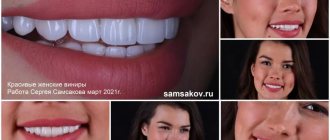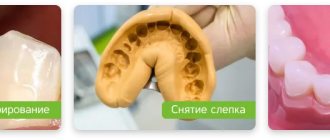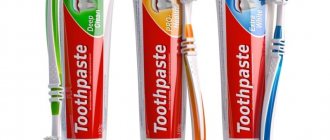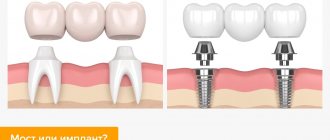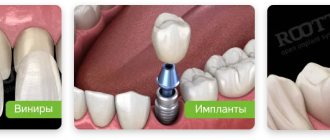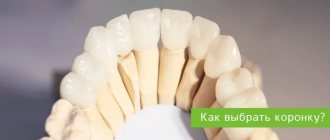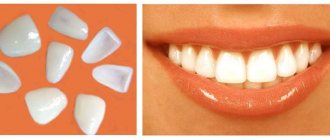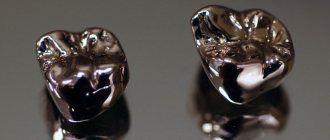Do you dream of a flawless Hollywood smile? Do you want your teeth to be perfectly straight and white, like those of Insta stars and celebrities? This is possible, and even for a very reasonable budget. At the 32 Dent clinic, you can completely restore your teeth using high-quality and modern veneers. Just a couple of visits to the dentist’s office - and you will get the same result that will pleasantly impress you and those around you!
Veneers are thin overlays 0.2 - 0.7 mm thick, which are fixed to the outer surface of their teeth using a special adhesive. They can also be called microprostheses, plates, prostheses, but the essence does not change. This is the most effective method in a couple of visits to the dentist to transform unaesthetic teeth into absolute perfection in color, shape and transparency!
This is interesting! The very first dental veneers appeared at the beginning of the 20th century in the USA, and they were intended for Hollywood stars (hence the phrase “Hollywood smile”). Initially, these were unnaturally white and rough in structure ceramic plates of impressive thickness, which made their teeth larger - it was visually noticeable that there were dentures in the mouth.
Modern designs are more advanced, but at the same time they look natural and aesthetically pleasing. You can easily verify this by looking at examples of the work of doctors at the 32 Dent clinic. The result will impress you!
Who is recommended for veneers and who is not?
In principle, any patient can get dental veneers if they have the funds and the desire. Most often, veneers are installed on teeth for the following reasons:
- not satisfied with the natural color of your teeth;
- there are stains or microcracks on the tooth surface that you want to disguise;
- if there are three (small distances a few millimeters wide);
- in cases where teeth are prone to increased wear at the edges;
- if there are minor orthodontic defects, for example, the tooth is slightly rotated, or mild crowding is diagnosed.
Note!
Even the most modern whitening technologies are not able to give tooth enamel such impeccable whiteness as microprostheses. That is why more and more patients are inclined to install veneers and make their dream of incredibly beautiful teeth come true! Like any restoration procedure, the installation of veneers has its contraindications. It will not be possible to install dental microprostheses if:
- the patient suffers from bruxism - otherwise, microprostheses will constantly break;
- when your teeth are loose and in poor condition, prosthetics will help here (possibly together with implantation);
- if the enamel thickness is insufficient or it is destroyed, then the microprosthesis will not hold;
- the teeth are naturally underdeveloped, too small - the structures simply will not be fixed on the surface;
- there are acute diseases of the ENT organs, problems with the heart and blood vessels, tumors, etc.
Relative contraindications are problems with bite and caries - these issues can be treated, and only after that you can work on the aesthetics of your smile.
Note! If a tooth has been restored by more than 60%, it has a large filling, and it is not advisable to install onlays on it. This can lead to subsequent destruction of the crown, and the patient will already spend a considerable amount on the installation of dental microprostheses. Perhaps in this case, prosthetics at the 32 Dent clinic will help.
When is the best time to get crowns?
Crowns differ from veneers in their wear resistance; they can be installed on both front and chewing teeth. These caps are installed on a heavily ground tooth, pin or inlay. If the tooth is severely damaged or completely missing, doctors recommend installing a crown.
In order to install a crown, the doctor grinds down the tooth (removes about 2 mm of enamel). This procedure is painful, so anesthesia is required. If the tooth is severely damaged, but the root of the tooth allows you to install a crown, then it is placed on a pin. Then the dentist screws a pin into the gum canal or installs a metal tab, thus simulating the base of the tooth. A crown is placed on this structure (it can be made of any metal, even gold).
Nowadays, only the older generation has gold teeth, because it is not very aesthetically pleasing. Plastic crowns are placed temporarily, as are metal-plastic crowns, but the service life of the latter is slightly longer - up to 3 months.
Metal-ceramic crowns are considered the most durable and common option. Ceramic ones also look beautiful, but they are less durable than metal-ceramic ones. Crowns made of zirconium or lithium disilicate are quite durable and look visually aesthetically pleasing, like natural ones. Their only drawback is their high cost. The service life of crowns is from 10 to 15 years.
What you need to be prepared for when deciding to install veneers on your teeth
Unfortunately, patients are not always aware of all the points associated with these structures.
- The crown must first be ground. In most cases, when installing veneers, the enamel must be prepared (remove a microscopic layer) - otherwise, the overlay will stick out and provoke an unattractive effect. But in this case, you can choose an alternative - ultra-thin lumineers, which are attached to the enamel without pre-turning, but at a price - they are much more expensive than conventional onlays.
- Not for life! When deciding one day to put veneers on your teeth, be prepared that in a few years you will have to replace them with new ones. Even the best pads won't last a lifetime. If we are talking about composite veneers, they will have to be replaced after 5 – 7 years.
- Beware of caries! Unfortunately, even the best and well-installed structures do not guarantee that caries will not develop under them. Therefore, experts recommend that patients with veneers monitor their oral hygiene even more carefully and undergo regular preventive examinations in the clinic.
- Pleasure is not cheap. This is not only about the beauty of teeth, but also about the need to invest periodically. So, for example, if one pad breaks or comes off, it will have to be replaced with a new one, which also costs money. However, by investing in your health and beauty, you get much more!
How are veneers different from crowns?
Before we talk about installing crowns or veneers, it is necessary to understand what their differences are. Veneers are thin plate-like coverings on teeth, which are fixed on the front surface of the teeth. Their main function is to hide unsightly teeth and create the effect of a “Hollywood smile.” Veneers hide all kinds of defects, strengthen the hard tissue of the tooth and protect the natural tooth from damage and darkening.
Such plates cover the vestibular part of the tooth. The onlay is firmly held due to the fact that the dentist first saws off the hard tissue along the outer surface and makes notches. In society you can see many people with a beautiful smile, but it is impossible to understand whether it is a natural tooth or a veneer. After all, modern records are aesthetically pleasing, and even upon close examination one cannot guess that there are veneers on the teeth. It will remain a secret.
Veneers are placed when teeth have chips, cracks, various cosmetic defects, stains, or the tooth is not very damaged. Doctors recommend installing plates on the front teeth or fangs, because installing veneers on molars is irrational.
Caps, called crowns, are placed on previously ground teeth. They cover five surfaces of the tooth, so it is protected from any influence. If the tooth is destroyed by more than 50%, that is, the natural tissues are almost lost, the dentist will recommend installing a crown. There are crowns made from different materials:
- ceramic;
- metal-ceramic;
- metal;
- plastic;
- zirconium.
It is clear that veneers or crowns are an opportunity to make a smile beautiful, but what is the difference between these two types of overlays? There are many differences, including the following:
- if the crown covers the entire tooth, covering it along the neck of the tooth, then the veneer is installed on top of the tooth only on its front surface;
- installation of veneers involves minor grinding of the tooth enamel, and sometimes (when choosing the appropriate veneers) filing of the surface is not required; to install a crown, it is necessary to grind the tooth when a large amount of tissue is removed - this is often required when installing a metal-ceramic structure;
- if the tooth is destroyed or there is a large filling, installation of veneers is impossible;
- veneers are placed from canine to canine, sometimes covering premolars that are visible when the patient talks or smiles; that is, veneers, unlike crowns, are not placed on chewing teeth;
- The crown not only protects the tooth, but also strengthens it and allows it to withstand increased loads.
What types of veneers are there? Which is better to choose?
Conventionally, three groups of restoration structures for teeth can be distinguished, if we take into account the specifics of their installation:
- Direct – plates that are installed directly in the dentist’s chair. The specialist first grinds the tooth, after which he applies the composite material layer by layer - by analogy with artistic restoration. As a result, it is possible to obtain a beautiful “new” tooth in shape, color and transparency. The main advantage of direct overlays is their price. The main disadvantage of direct structures is that over time, the composite material still darkens, turns yellow, and the aesthetics are no longer the same.
- Indirect - onlays that are made in advance using impressions taken from the patient’s ground teeth. After the plates are ready, they are tried on the prepared teeth, and then they are fixed using an adhesive composition. While the veneers are being produced in a laboratory, special temporary structures are placed on the patient’s teeth (similar to temporary dentures). The main advantage of indirect solutions is that they are more durable and do not change their color and transparency throughout their entire service life. The main disadvantage of indirect overlays is their high price compared to composite plates.
- Semi-direct – a combination of the two technologies listed above. First, impressions of the patient’s teeth are taken, and new onlays from composite material are made in the dental laboratory. The main advantage of semi-direct veneers is that their fixation to the teeth is considered more reliable. The main disadvantage of semi-direct options is that composite linings still last no more than five years; over time, they will have to be replaced with new ones.
As you can already understand from our examples of clinical cases, dentists distinguish two categories based on the material of manufacture:
- Composite – dental onlays made of filling composite. In some cases, they can be installed without first grinding down your tooth. For example, when there are microscopic cracks in the enamel, or the patient is not satisfied with the shade of the tooth enamel. A thin layer of composite material will mask these moments and allow you to achieve ideal whiteness of your teeth. There will be no visible transitions from the composite composition to the native tissues of the tooth enamel.
- Ceramic – dental plates made from dental ceramics. More advanced solutions in terms of creating ideal tooth shapes. They will help to align and achieve ideal anatomical proportions of teeth, since the structure of the material is as close as possible to the characteristics of natural enamel. At the same time, the price of ceramic analogues is three or even five times higher than the price of classic composite overlays.
Which veneers are best to choose? The question is strictly individual. To answer this, the dentist must:
- assess the condition of the patient’s teeth;
- see the condition of the jaw and exclude serious orthodontic abnormalities;
- find out the goals pursued by the patient who wants to install linings from a particular material;
- roughly be aware of the allocated budget for smile restoration.
It is important! In case of severe curvature of the teeth or pathologies of the jaw, guilt is undesirable. But the patient can always straighten the teeth first and then install veneers to get the picture of their dreams.
As practice shows, ceramic structures are still more preferable. Firstly, this is quality that will prove itself within 20 years. Secondly, it is reliable; teeth will not darken from coffee or cigarettes in a year. Thirdly, if you calculate the budget for installing composite systems every 5 years, then installing ceramic veneers is more profitable from a financial point of view.
Among the most common ceramic veneers, we note 4 directions:
- Zirconium dioxide dental veneers – the main part is made of zirconium alloy, and the top is coated with dental porcelain. They are considered one of the most reliable and durable, but in terms of their tint range and transparency they may be inferior to glass ceramic linings;
- Made from glass ceramics – so-called metal-free plates, which are made in a dental laboratory from pressed glass ceramics. The most popular plates you may have heard of are E Max CAD and E Max Press;
- Porcelain dental veneers are the “gold standard” of designs that combine optimal price and quality. Dental porcelain is the same ceramics, but with characteristics closer to natural enamel;
- Ultra-thin or lumineers are dental onlays approximately 0.02 millimeters thick. They are considered the thinnest, their installation does not require preliminary grinding of the enamel, but their cost is several times more expensive than classic porcelain ones.
Removable veneers
Modern manufacturers offer a large selection of products for whitening teeth, keeping them clean, and also for restoring a smile without the intervention of specialists. In online stores you can purchase silicone jaws that imitate real, healthy teeth. However, they can only be used as a toy or souvenir, since serious discomfort will occur when worn.
The reason is that real removable veneers are made from an impression, as a result of which they are very comfortable and are practically not felt even with active articulation. Mass produced pads may not fit properly and may fall out or become dislodged. Cheap analogs may be made from low quality material, which can cause an allergic reaction in a sensitive person.
Why do they make a cast? The thing is that all people's teeth have different shapes, heights and widths, they are located at different distances from each other. Only based on individual parameters it is possible to create truly comfortable, strong and durable veneers. Agree, even the most beautiful teeth will be unpleasant to use if they prevent the jaw from closing freely.
Installation of veneers: features, important nuances that the patient should know better about
The indirect method involves 3 steps:
- Preparation. First, the tooth enamel is ground down a few tenths of a millimeter - a thin layer of enamel is removed. Then the dentist makes impressions of the patient’s also prepared teeth, after which he covers them with special protective caps - for the period of time while the veneers are produced in the laboratory;
- Visualization. Computer model with “before” and “after” effect. In a 3D program, the dentist creates a virtual model of teeth and clearly demonstrates how it was and how it will be after. The picture is usually impressive and motivating;
- Installation of veneers - your new perfect smile is ready! The dentist fixes the onlays on the tooth enamel, and the patient evaluates the final result.
Installation of microprostheses using the direct method also involves 3 steps:
- Preparation. The dentist removes a small layer of tooth enamel for the patient and prepares the teeth for further restoration;
- Installation of composite structures. Layer by layer, the dentist distributes the composition over the surface of the enamel, while each of them is illuminated with a lamp to “seal”;
- Polishing and finishing to perfection. The enamel surface is carefully polished, the shape of each tooth is brought to perfection.
Indications and contraindications for installation
Indications:
- Minor enamel defects - chips, cracks
- Pigmentation of the enamel layer that cannot be lightened
- Slightly crooked teeth
- Slight crowding of teeth in a row
- Unattractive shape of dental elements (or their small size)
- Enlarged interdental spaces (diastemas and trema)
- Increased abrasion of the enamel layer
Contraindications:
- Complex occlusion defects
- Diseases of teeth and gums (temporary ban)
- Severe destruction of the prosthetic element (more than 45%)
- Passion for hazardous sports (boxing, hockey)
- Bruxism
Note: if the patient is ready to wear a mouthguard every night at night, then veneers can be installed for bruxism.
Price question: how much does it cost to install veneers?
As we already said, dental veneers are not cheap, but they are worth it!
Approximate cost of microprostheses:
- Composite ones are the most budget-friendly. The cost of one unit is approximately 7 thousand rubles;
- Ceramic microprostheses, which are manufactured in a dental laboratory, cost approximately 20 thousand rubles per unit;
- Ceramic dental veneers made at the 32 Dent clinic will cost the patient about 15 thousand rubles per unit;
- Lumineers are the most expensive - from 50 thousand rubles per unit.
The process of creating a smile using veneers
The main advantage of ceramic veneers is minimal treatment of teeth within the enamel, or its absence according to individual indications, as well as a progressive protocol for carrying out manipulations with a minimum number of patient visits to the clinic and achieving an excellent aesthetic result.
During the first visit to the patient, the NKclinic orthopedic dentist finds out the patient’s complaints and wishes. Diagnostics are carried out: visual inspection, photography, diagnostic impressions are taken. A study and assessment of occlusion is carried out, registration of functional movements of the lower jaw and variants of its relationship with the upper jaw.
After this, the orthopedic dentist, together with the dental technician, plan future work using wax modeling of the new shape of the teeth on a plaster model, using 3D programs. The resulting preliminary result is sent to the clinic for fitting and approval of aesthetic nuances with the patient.
3D planning of future restorations by an NK Clinic specialist
The final result of the work, made using 3D planning
On the same day, future restorations using fast-hardening composite material are assessed. The patient, together with the doctor, determines the appropriate size and shape of his future teeth. The doctor decides whether it is necessary to treat the teeth and to what extent.
At the next visit, the doctor, taking into account all the parameters, carries out the final preparation of the teeth for restoration and takes working impressions, and mock-ups of temporary veneers are fixed on the teeth. The fabricated ceramic restorations are tried on behind the teeth using water-soluble colored pastes to simulate the fixation of the veneer and evaluate the color.
Different shades of pastes allow you to clearly demonstrate the color palette and make it easier for the patient to choose the shade of their future smile and final fixation is carried out according to all the rules of the adhesive protocol.
How can you save on installing veneers?
There are two ways to go. Place veneers on individual teeth for the patient. For example, for 10 units of the upper jaw - provided that your teeth are in good condition. You can whiten the enamel of your teeth, but the result will not always be perfect.
There is also a solution to take advantage of the favorable conditions of clinics. Thus, 32 Dent dentistry regularly holds promotions and special offers for the installation of veneers. There are opportunities to install dental microprostheses at a discount of 15% to 50%. The quality of work is at the highest level, as are the guarantees.
Author's HandMade veneers at NKclinic
Teeth are no less individual than their owners. The new shape of teeth and their sizes are “designed” at NKclinic not only taking into account the canons of symmetry and the golden ratio; Age, gender factors, features of the smile and even the character of the future “owner” are also taken into account. We don’t just make overlay plates, but we make them as individual and natural as possible, truly yours.
Dr. Kyalov: “The main task of orthopedic veneers is to create teeth of natural beauty, taking into account light transmission, brightness, and transitional shades of color like natural teeth.”
Installed dental veneers at NKclinic
Designer veneers from NKclinic convey a slight color gradient of a natural tooth using ceramics of different shades and transparency. Our dental technicians accurately reproduce the anatomical structure of the tooth, from the tubercles and fissures (cavities) of the chewing surface to the incisal edge of the front teeth. The shape of the veneer necessarily takes into account the position of the teeth of the opposing dentition, making the bite functional.
To achieve maximum resemblance to a natural tooth, almost jewelry work is performed: each veneer is sculpted with a special mini-brush. Color effects are created between the ceramic layers. The result, comparable to the work of a miniaturist, fully conveys the natural differences in color and the play of shades on the slightest unevenness of the relief.
NKclinic works at the intersection of dentistry and art. Our limited-edition approach will certainly be appreciated by true fans of excellence who want to achieve a truly unique smile.
Hit list of questions and answers about veneers
Do veneers ruin your teeth?
Answer: teeth are spoiled by carious lesions, neglect of hygiene rules, lack of regular visits to the dentist, poor nutrition, and bad habits. Veneers, made of first-class material and installed by a professional dentist, on the contrary, protect the enamel from harmful external influences.
Is it painful to install?
Answer: no, it doesn't hurt. The procedure is performed under local anesthesia in a comfortable environment. It is important! There is no need to remove dental nerves during installation.
How long will it take to install?
Answer: on average, from 5 to 14 days or 2 to 3 visits to the dentist’s office.
Dental clinic "32 Dent" specializes in the installation of dental veneers on a turnkey basis. Both budget-class microprostheses and premium solutions are available, including patented American lumineers. Schedule an initial consultation with your doctor to choose the best path to restoring your smile with veneers. The smile will be beautiful and at the same time natural. Take action!
Veneers: service life, reviews
Dental patients often have doubts about the strength of veneers, because their thickness is very small. Porcelain is one of the highly durable materials, but it is fragile. In order for the veneer to gain durability, it is fixed to a strong base of natural tooth enamel. This allows for a strong, durable and reliable design.
Experts conducted studies that allowed them to evaluate the “survival” of veneers. After 7 years of use, in 86% of cases, veneers that do not overlap the cutting edge of the tooth retained their appearance unchanged. For veneers that covered the incisal edge of the tooth, the survival rate reached 96%. this indicates the incredible reliability of ceramic veneers and the minimal likelihood of problems with them. More often, dental patients complain about braces than they experience difficulties with veneers installed on their teeth.
Often, braces and veneers lose their characteristics due to the fault of the clients themselves. Violation of oral hygiene, sudden severe injuries, and exposure of teeth to critical temperatures are unacceptable.
Composite veneers: reviews
The service life of composite veneers is limited to 2-3 years. In an ideal situation, if the dentist strictly followed the technology, the period of use of veneers will increase to 4 years. Like braces, they require periodic maintenance. Composite veneers need to be polished regularly. This will not stop the gradual fading and darkening of the surface.
Author's veneers at NKclinic
Few people in the modern world can say that they are satisfied with their natural smile. Some defects, such as malocclusion and underdeveloped teeth, are congenital. During life, teeth are also exposed to negative environmental influences, including harmful industries, injuries and bad habits, which can lead to cracks, chips, and slight discoloration. Incorrect bite, without timely orthodontic correction, leads to increased tooth wear, which is a direct indication for reconstructive orthopedic dentistry.
For NKclinic specialists, making veneers is a responsible as well as creative process. At the same time, the finished product is inimitable and unique. Despite the large-scale introduction of digital technologies, doctors at our center exclude the use of template, standardized methods for manufacturing ceramic structures.
At NKclinic, the main principle of the work of the chief physician, Grigory Georgievich Kyalov, is to create teeth of natural beauty, taking into account the optical properties of hard dental tissues: light transmittance, brightness, transitional shades of color, like natural teeth. This makes it possible to emphasize your individuality, place the right accents and add charm to your smile.
The key to achieving maximum aesthetic results is individualized, multidisciplinary treatment planning. Often, in addition to the orthopedic stage, the patient needs surgical correction of the gingival margin, which allows the formation of the correct gingival contour. Get proper periodontal care.
Aesthetic and functional analysis of the dental system as a whole consists of a comprehensive study of each clinical case individually. This takes into account the structural features of the skull, the trajectory of the lower jaw, as well as facial features.
To achieve the most predictable and accurate results, we use digital technologies in combination with the practical and clinical experience and knowledge of our center’s professionals.
Orthopedic treatment planning:
- Medical photography to assess the aesthetic parameters of the patient’s face and determine individual anthropometric data.
- Creating 3D photographs of a face.
- Digital scanning, which, in combination with the manual skill of the doctor, allows you to obtain highly accurate three-dimensional digital models of the jaws and bite in a matter of minutes.
- 3D modeling makes it possible to compare medical photographs of a patient with digital models of the jaws, combined with computed tomography and 3D photography to predict the outcome.
- Digital modeling of teeth according to the patient's smile to achieve facial harmonization. The use of a virtual articulator allows you to build a physiologically correct bite.
- Making a 3D model on a 3D printer.
After this, our doctors make a mockup, i.e. transfer of a prototype of future orthopedic structures into the oral cavity.
At this stage, the design of future teeth is agreed upon with the patient, namely the color, shape, size and other nuances of the future smile.
This layout allows the orthopedist to prepare the teeth in such a way as to correctly convey the optical effects for maximum naturalness of the smile, as well as to easily install the ceramic structure in the oral cavity at the fixation stage, while maintaining the maximum thickness of the natural tooth tissues. Kyalov Grigory Georgievich individually selects materials for each specific case. Our goal is not to sell the most expensive technology. We work for high results and select the best solution for our patients.
Ceramic veneers are made from sintered ceramics, which has maximum aesthetic properties close to the properties of natural tooth enamel, therefore an important condition is the preservation of the enamel layer of the tooth.
NKclinic doctors work at the intersection of scientific and practical dentistry and art. Our approach will certainly be appreciated by people who want to achieve a truly unique smile.
